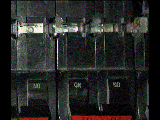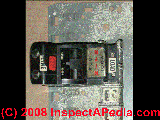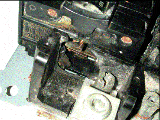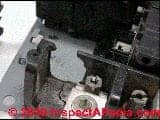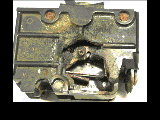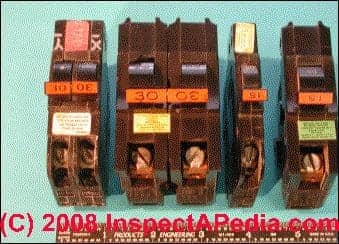 FPE Stab-Lok® TECHNICAL REPORT - Hazardous FPE Circuit Breakers and Electrical Panels - 2004 - 2007 - obsolete -
FPE Stab-Lok® TECHNICAL REPORT - Hazardous FPE Circuit Breakers and Electrical Panels - 2004 - 2007 - obsolete -
see FPE HAZARD REPORT - 2017 [PDF]
- POST a QUESTION or COMMENT about fire and no-trip hazards involving FPE Stab-Lok® electrical panels and circuit breakers
Federal Pacific Electric Stab-Lok® Electric Panels and Circuit Breakers: Information for Inspectors and Homeowners Prepared for the 17th Annual Spring Seminar, Feb. 21, 2004 St. Louis Chapter, [ updated through additional FPE Stab Lok failure research reported in 2011], American Society of Home Inspectors.
This paper provides a thorough and detailed explanation of the electrical and fire hazards associated with Federal Pacific Electric Stab-Lok® (FPE Stablok) circuit breakers and electrical panels, presents the results of independent testing which demonstrate a high rate of failure of these circuit breakers to trip, summarizes the history of this problem in buildings, and offers repair advice.
InspectAPedia tolerates no conflicts of interest. We have no relationship with advertisers, products, or services discussed at this website.
- Daniel Friedman, Publisher/Editor/Author - See WHO ARE WE?
The Federal Pacific Electric Stab-Lok® Equipment Hazard Explained
J. Aronstein Consulting Engineer, Mechanical and Materials Engineering, BME, MSME, Ph.D., N.Y.S. P.E. LIC. NO. 39860, 50 Pasture Lane, Poughkeepsie N.Y. 12603 - 845-462-6452 - EMail protune@aol.com
The latest version of this report is found at HAZARDOUS FPE CIRCUIT BREAKERS AND PANELS - 2024 [PDF] independent research article by Jess Aronstein, supercedes older FPE / FP hazard reports by this author.independent research article by Jess Aronstein, supercedes older FPE hazard reports by this author.
The new .pdf version at the link shown immediately above includes results of additional, more extensive testing performed by Dr. Aronstein and is the document which you should print and use in distribution to people who need to know the testing and technical details which support the identification of Federal Pacific Stab-Lok® electrical panels and circuit breakers as a latent safety hazard.
Supposing the circuits in your home were fed by a fuse box, with screw-in (Edison base) fuses. You may have seen these in some homes. You may also know about the common (but unsafe) practices of over-fusing (installing a higher-amperage fuse) or putting a penny in the fuse socket behind the fuse itself. These actions were taken to deal with the nuisance of fuses frequently blowing on overloaded circuits, or to deal with the lack of a spare fuse.
Now, let's assume that an inspector notes some over-fusing and pennies behind some fuses, and waves the warning flag that it is a hazardous condition - a "safety defect". Inspectors, electrical contractors, and even realtors would agree that these conditions constitute a hazardous condition and should be corrected immediately. Red-flagging the Federal Pacific Electric ("FPE") Stab-Lok® ® panel is essentially the identical warning; it is the exact equivalent of having more than 1/3 of the circuits over-fused and/or with pennies behind the fuses.
Failure to trip properly under overload and/or short circuit is the basic safety defect of the FPE breakers. For example, if an overload or short circuit occurs in the clothes dryer or the circuit feeding it, the breaker is expected to trip open to minimize the resulting fire hazard.
But, if it is an FPE Stab-Lok® ® two-pole breaker, extensive testing (by FPE, CPSC, UL, and others) has demonstrated that it cannot be depended on to trip properly. In the CPSC tests, a substantial portion of the FPE two-pole Stab-Lok® ® breakers, the type that would feed the dryer circuit, failed to operate properly.
A significant portion of them jammed and would not trip at all, no matter what overload current was applied.
Additional test data shows that there are also problems with the FPE Stab-Lok® ® single-pole breakers and combination breaker/GFI units.
This type of safety defect becomes important if and when there is a short circuit or substantial overload in the downstream circuit. Most breakers in a home are never called upon to trip, and the homeowner's perception is that "the breakers work fine".
The same observation could generally be made if there were no breakers (or fuses) at all, just a hardwired system. In the event of an electrical malfunction, however, our safety may depend on proper operation of the circuit breakers.
In my own home, only two of the breakers have ever tripped during more than a quarter-century of our occupancy. I know nothing about the ability of any of the others to function properly, except that they are a brand and type that has not been identified as having any significant performance problems. There is no data suggesting that I should be concerned about their ability to function properly. With FPE breakers, however, there is a significant amount of test data and other information available that indicates a serious problem.
Additionally, there are safety problems in many of the FPE panelboards (panels), in which the breakers are installed. Some of the most common FPE Stab-Lok® ® panels are failure-prone due to marginal interconnections between the current-carrying components. The failing interconnections overheat at high current loading, and, in the worst case, fire ignites within the panel.1
Details regarding both the FPE Stab-Lok® ® circuit breaker and FPE panel performance problems are provided in the following sections
The bottom line is this: based on the information that is available and the testing that has been performed, there is no question but that homeowners need to be alerted to this safety defect and advised to have it corrected. Unless the occupant is willing to live with the risk, the FPE Stab-Lok® ® panels should be replaced.
1. FPE Stab-Lok® ® CIRCUIT BREAKER TEST RESULTS
1.A. CPSC Tests In the 1980 time frame the U.S. Consumer Product Safety Commission (CPSC) investigated the performance of FPE Stab-Lok® ® full-width double-pole circuit breakers in ratings from 30 Amp to 80 Amp.2, 3, 4 O
ne hundred and twenty two of these breakers were tested for CPSC (at Wright-Malta Corp.) to the Underwriters Laboratories' (UL) criteria, which included tests at 135% and 200% of rated current. The breakers should trip (open the circuit) at these currents within a specified time, with the current applied to either one pole or both poles.
The two-pole breakers are essentially two single-pole breakers ganged together with linked handles, and they may or may not have an internal "common trip" mechanism, which is intended to assure that tripping of one pole causes both poles to open. Older FPE Stab-Lok® ® two-pole breakers do not have this feature.
FIGURE 1 - HALF- AND FULL-WIDTH FPE Stab-Lok® ® CIRCUIT BREAKERS
(left to right: 1/2-width double pole, full-width double pole,
11/2-width single-pole, full width single-pole)
For the test at 135% of rated current, 51% of the breakers failed with individual poles tested, and the failure rate was 25% with both poles tested simultaneously. The failure rates increased to 65% and 36%, respectively, after 500 operations of the on/off toggle handle.
[Click to enlarge any image]
For the test at 200% of rated current, the failure rate was 1% on individual poles tested, and 0% with both poles tested simultaneously. The failure rates increased to 10% and 1%, respectively, after 500 operations of the on/off toggle handle.
From an electrical safety standpoint, the most significant hazard identified in these CPSC-sponsored tests is that many of the two-pole FPE Stab-Lok® ® breakers may jam when trying to trip from overcurrent on one pole. This is due to mechanical friction in the common trip mechanism. Once the circuit breaker jams, its contacts will remain closed no matter what the current loading.
This is serious -- a total failure that disables the protective device for that circuit. Essentially, the jammed breaker is exactly analogous to the "penny behind the fuse". This type of failure occurred in about 10% of the two-pole breakers.
The balance of the overcurrent failures are similar to "overfusing". For instance, a 30-amp breaker, which is normally expected to trip somewhere above 30 amps and below 40.5 amps (the UL 135% test point), actually doesn't trip until 44 amps.
The 30-amp breaker is essentially a 40-amp breaker. This is analogous to the condition of "overfusing" -- perhaps not as dangerous a failure as a totally jammed breaker, but nevertheless generally considered to be an unsafe practice.
CPSC performed laboratory and in-home testing of additional FPE breakers, both single-pole and double-pole. No detailed test results or reports from this portion of the CPSC investigation are available.
Federal Pacific Electric and/or their parent company Reliance Electric investigated their own circuit breakers and notified CPSC) of problems associated with their two-pole Stab-Lok® ® residential breakers.5 They have never made public any test data or technical reports on the 2-pole or any other breakers in their line. Recently, a homeowner reported that when he called FPE he was told that FPE had performed the same tests (as CPSC), but no details regarding the test results were provided. When the homeowner asked for the test results, he was told that they did not have them.
1.C. Southwest Research Incorporated p
erformed testing under contract to FPE/Challenger regarding the performance of the FPE two-pole residential Stab-Lok® ® breakers and the potential hazards resulting from overcurrent conditions.5, 6 Their reports have not been made public. Lacking any information to the contrary, it must be concluded that the results of their functional tests on the two-pole breakers were consistent with the findings of FPE and CPSC as to the defective performance.
1.D. Underwriters Laboratories Inc. h
as never made public any of its test data on FPE breakers.
1.E. Recent Testing of Field Samples
The latest version of this report (May 25, 2007) is available in PDF FORMAT (1.2 MB). The new .pdf version at the link shown here includes results of additional, more extensive testing performed by Dr. Aronstein and is the document which you should print and use in distribution to people who need to know the testing and technical details which support the identification of Federal Pacific Stab-Lok® electrical panels and circuit breakers as a latent safety hazard.
This updated test report of independent testing (a large 1.2MB PDF file) using a larger pool of FPE Stab-Lok® circuit breakers than the older CPSC and Wright Malta tests found significantly higher failure rates of FPE Stab-Lok® circuit breakers, including a look at critical safety failures (breaker failed to trip at 200% of rated current or jammed) which found up to 80% failure rate for FPE Stab-Lok® GFCI circuit breakers (n=4), 12% failure rate for double pole FPE Stab-Lok® circuit breakers (n=120), and a 1% failure rate for FPE Stab-Lok® single pole circuit breakers (n=345).
Over the past several years, I have acquired 17 FPE residential panels complete with their circuit breakers from homeowners in various parts of the United States who have had them replaced. Table 1, below, presents a summary of the test results to date (1/22/04) for the FPE Stab-Lok® ® breakers from the 17 field sample panels.
Type of Breaker |
Tested |
No-trip Failures @135% of rated current |
Jammed |
FPE Single-Pole, 1/2 Width |
159 |
25 |
1 |
FPE Single-Pole, Full Width |
53 |
4 |
0 |
FPE Single-Pole, GFI/Breaker |
3 |
2 |
2 |
FPE Double Pole, 1/2 Width* |
17 |
7 |
4 |
FPE Double Pole, Full Width* |
14 |
8 |
2 |
* 2-pole breakers tested on individual pole overload
TABLE 1 - SUMMARY OF FPE Stab-Lok® ® CIRCUIT BREAKER TEST RESULTS
(field samples from 17 homes, results as of 1/22/04)
This most recent testing of field samples has provided data on FPE single-pole Stab-Lok® ® breakers. No test results data on these had previously been available. The failure rate among the 215 single-pole units tested (including the combination GFI type) was 14%. One of the 1/2-width single-pole breakers jammed with the contacts closed, as did two of the GFI types.
The recent testing has also provided data on the 1/2-width double-pole FPE Stab-Lok® ® breakers, which also had not been previously available. The data shows no significant difference between the 1/2-width and full-width double pole breakers. Overall, among all of the 31 two-pole breakers tested to date from these 17 panels, the failure rate was 48%, and six of them (21%) jammed with contact(s) closed.
The results of the recent testing clearly demonstrate that the circuit breaker problems are not restricted to the full-width two-pole breakers that were the focus of the CPSC investigation. The problems extend across the full Stab-Lok® ® circuit breaker line, including the combined breaker/GFI type.
2. FPE Stab-Lok® ® COMBINATION BREAKER/GFI
Three FPE Stab-Lok® ® breaker/GFI units were among the field samples tested. Two of them failed. This is not surprising, since the breaker/GFI design is based on the 1/2-width two-pole breaker, which is prone to jamming due to the common-trip mechanism.
The single-pole breaker/GFI is essentially a double-pole breaker with one side actuated by a special circuit that reacts to a small (5 milliamp) difference in current between the line and neutral conductors passing through it. When the common trip mechanism causes a jam, it defeats both the circuit breaker and GFI functions.
Two of the three units tested jammed. While the sample size is not large, it is nevertheless significant because it was a truly random sample. The three units tested were from different panels in different parts of the country.
A previous sample can be added: a field failure in which an FPE Stab-Lok® ® breaker/GFI "protected" a lighting circuit in which a short circuit occurred between a switch and its grounded metal cover plate. The event, which resulted in a serious injury, formed a relatively large globule of melted brass at the point of arcing. The melting could not have happened if the breaker/GFI had opened the circuit at the milliamp level of current flow. That FPE Stab-Lok® ® breaker/GFI was subsequently tested and was definitely determined to be defective. Altogether, including this previous sample, I have crossed paths with four FPE Stab-Lok® ® breaker/GFI units, three of which were defective.
3. NON-FPE Stab-Lok® ® BREAKERS
Since the end of manufacturing of circuit breakers under the Federal Pacific Electric (FPE) brand, compatible Stab-Lok® ® type breakers have appeared under names such as "American", "Federal Pioneer", "Challenger", "Federal Pacific Reliance Electric", and "Federal Pioneer Limited" (Canada).
There is no data available at this time on which to base a sound judgment as to their reliability relative to the FPE breakers. In many instances, these are essentially the same product as FPE. Whether or not any substantive changes in design or manufacturing were made to solve the known problems associated with the original FPE Stab-Lok® ® breakers is not known.
Although there have been incident reports in which FPE main breakers have failed to trip under circumstances in which people thought they should have, there is no test data available on which to base any conclusion - one way or the other - as to the reliability of the main breakers utilized in FPE Stab-Lok® ® residential panels.
(It is also important to note that FPE panels in some homes do not have a main circuit breaker. See section 6.)
Even if it were possible to replace all of the suspect FPE Stab-Lok® ® breakers with a more trustworthy type, that would not correct hazardous internal failure modes intrinsic to many of the FPE panels. Five of the seventeen FPE Stab-Lok® ® panels in the present study showed evidence of internal overheating due to this type of failure. The overheating ranged from mild to severe in these failing panels.
The "panel" is the unit within the enclosure, on which the breakers are mounted. The main electrical service feeders (electrically live, from the meter) are connected at the panel, and the panel has an internal conductor system that distributes the power to the individual circuit breakers.
The internal conductor system consists essentially of "bussbars" (thick metal bars) that have sockets incorporated or attached, into which to which the breakers' "stab" contacts are inserted. There are at least three basic types of bussbar constructions in FPE panels, and these are shown in Figure 2.
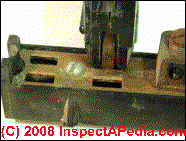 |
 |
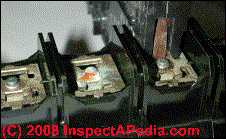 |
A. Copper buss bar with |
B. "Z" clip, clamped to |
C. Stab socket on a post, |
Bussbar with 10-32 screw, attached with an 8-32 steel screw. |
||
FIGURE 2 - THREE DIFFERENT FPE Stab-Lok® ® SOCKET DESIGNS
Of the three types illustrated, the one shown in Figure 2-C is known to have a high probability of deteriorating and overheating of the stab socket structures when subjected to significant current flow. Each individual stab socket plate is connected to its bussbar via a post (spacer), and the assembly is held together by an 8-32 steel screw. FPE panels with this construction are prone to overheating failure. The five panels of the present study that showed evidence of serious overheating were constructed this way. One example is shown in Figure 3.
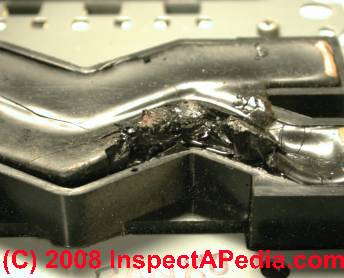
(This view is of the backside of the panel. The damage could not be seen unless the panel is taken out of the enclosure.) [Click for larger picture]
FIGURE 3 - OVERHEATING AT THE CONTACT BETWEEN THE BUSSBAR AND THE STAB SOCKET ASSEMBLY CAUSED THIS DAMAGE TO THE INSULATION.
A more serious failure of this type has been documented.1 In that instance, the failure had been severe enough to ignite a smoldering fire on the plastic insulating material. The fundamental weakness in this design is the use of a single, relatively flimsy screw to hold a structure together that can feed, for instance, a pair of 80-amp circuits.
That's a total of 160 Amps "ampacity" (rated
circuit capacity) connected via a structure clamped together by one 8-32 screw.
Figure 4 (below) shows how the stab socket plate and post are attached to the bussbar.
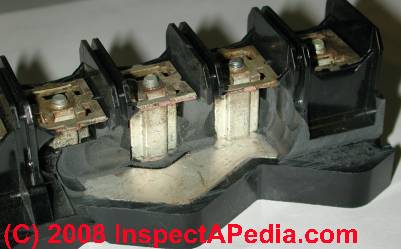
A. Cutaway - Bussbar, Post, and Stab Socket Plate. B. Bussbar, Screw, and Post
FIGURE 4 - CONDUCTING PATH FROM BUSSBAR TO STAB SOCKET PLATE
Various material combinations were utilized by FPE in these assemblies. Some bussbars are copper, others are aluminum. Some posts are copper, others are aluminum.
The worst case (most likely to fail) is where both the bussbar and the post are made of
aluminum, and the best case (least likely to fail) is where both are made of copper.
Inspectors (or homeowners, or electricians) have no way of knowing which materials are utilized in any particular
FPE panel with this type of construction.
Inspectors can, however, determine if a particular FPE panel has this type of construction, and, to a limited extent, whether it has failing bussbar interconnections that have previously overheated.
With the panel cover off, for this type of panel, you can see the screws holding the stab socket plate, as shown in Figure 5. The stab socket plates and the visible ends of the screws should have a bright metallic look. Darkening, discoloration, or signs of corrosion most likely indicate past episodes of abnormal heating.
[Click to enlarge any image]
FIGURE 5 - THE ENDS OF THE SCREWS HOLDING THE STAB SOCKET PLATES ARE
VISIBLE BETWEEN THE TWO ROWS OF BREAKERS. THIS IDENTIFIES IT
AS
A PANEL OF THE TYPE SHOWN IN FIGURE 2-C [
Some FPE Stab-Lok® ® panels have 100-amp main breakers that feed into the bussbars through the same plate and post system. In this design, the two main breaker output terminals do not have the stab type contact. Instead, each one is screwed down to a plate the same size as the stab socket plate, but which has a threaded hole in it instead of the stab openings. As with the plate and post assembly, the screws clamping the main breaker terminals are size 8-32, which is absurdly small for clamping the terminals of a 100-amp main breaker.
To put the diameter of the 8-32 screw in perspective, it is the same size as used on common receptacles for connecting #14 or #12 copper wire (for 15- and 20-amp circuits), and has a diameter of only about 5/32". An FPE panel and main breaker of this type is shown in Figure 6. The main breaker's output terminal mounting screws and the tiny allen-wrench that fits them are shown in Figure 7.
[Click to enlarge any image]
FIGURE 6 - FPE 100-AMP MAIN BREAKER CONNECTS TO THE BUSSBARS THROUGH THE PLATE & POST CONFIGURATION, USING ONE 8-32 SCREW AT EACH TERMINAL.
(The heads of the 8-32 terminal clamping screws are seen above and below the "LOAD" label.)
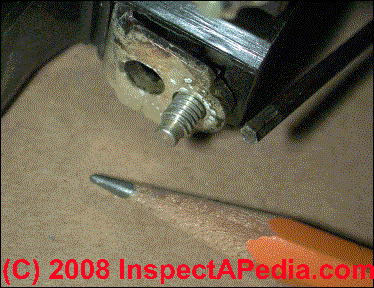
FIGURE 7 - ONE LOAD-SIDE CONTACT AND ITS 8-32 CLAMPING SCREW, ON THE FPE 100-AMP MAIN BREAKER OF FIG. 6. THE SCREW-HEAD TAKES A 3/32" ALLEN WRENCH, WHICH IS ONLY SLIGHTLY LARGER THAN THE LEAD OF THE #2 PENCIL.
(The larger hole provides clearance for the screw protruding from the stab contact plate)
6. FPE Stab-Lok® ® PANELS WITH "RULE-OF-SIX" CONFIGURATION
Many of the FPE Stab-Lok® ® panels that are in homes today do not have any main breaker. This was allowed under the so-called "Rule of Six" in the National Electrical Code (NEC), which states, typically, that "The service disconnecting means ... for each set of service entrance conductors ... shall consist of not more than six switches or six circuit breakers ..." (NEC 1981, section 230-71a, for example.)
This reduced the cost of the panel at the time of initial installation, but its nasty side effect is to totally eliminate the safety factor provided by having a main breaker.
In the event that a branch circuit breaker jams on an electrical fault, a main breaker would still provide a measure of circuit protection at a higher current trip point. Without the main breaker, there is no circuit protection at all if certain breakers jam. An FPE Stab-Lok® ® panel with the "rule of six" configuration is shown in Figure 8.
[Click to enlarge any image]
FIGURE 8 - FPE Stab-Lok® ® "RULE-OF-SIX" (SPLIT-BUS) PANEL WITH NO MAIN BREAKER. THE JUMPER CABLES ON THE RIGHT SIDE FEED THE LOWER SECTION.
There are many different design variations, but the essential element is that in these "rule of six" panels there is no main breaker, and, typically, the lower section of the panel is fed from jumpers coming from the output of one of up to six double-pole breakers in the upper section.
The FPE Stab-Lok® ® double pole breakers have a relatively high probability of jamming when called on to trip, however, as previously demonstrated by the test results presented in Section 1. That means that the home with an FPE "rule-of-six" panel has an unacceptably high probability of having one or more circuits that are totally unprotected, in which the maximum current flow is only limited by what the transformer on the pole can deliver. This is likely to be of the order of 1,000 Amps or more.
7. HAZARDOUS FAILURE - AN EXAMPLE
On first glance, the FPE Stab-Lok® ® panel previously shown in Figure 8 looks normal. In fact, however, it clearly demonstrates several of the hazardous failure modes discussed in the previous sections. It is one of 17 collected for the recent testing. It is from a home built in 1974, whose new owners had determined in 1999 that it should be replaced.
Their decision to replace it was in part prompted by information available on the internet regarding FPE breaker problems.7 According to the homeowner, who sent it to me for examination and testing, "We recently had it replaced and found the breaker to the dryer fried in just the way described. Our electrician was astonished. Two others we had bids from dismissed our concerns with contempt."8
Viewing the panel from the front, some signs of overheating, as previously discussed (p. 7) are evident. These are subtle compared to the view looking down at the top right (dryer) breaker, as in Figure 9.
FIGURE 9 - VIEW DOWN TOWARD UPPER RIGHT OF PANEL SHOWN IN FIG. 8.
THE FPE Stab-Lok® ® TWO-POLE 30-AMP BREAKER FED THE CLOTHES DRYER.
The main service cable connector has been rotated out of the way for better visibility of the damage.
The
plastic insulator is burnt and cracked. The breaker's internal mechanism can be seen through the
hole burned through its side. Figures 10 and
11 show the damage to the separate items.
[Click to enlarge any image]
FIGURE 10 - THE DAMAGE TO THE INSULATING STRUCTURE OF THE PANEL (FIG. 8) IS MORE CLEARLY VISIBLE WITH THE BREAKER REMOVED.
[Click to enlarge any image]
FIGURE 11 - THE FAILED FPE STAB-LOC® DRYER BREAKER (UPPER RIGHT IN FIG. 8)
The damage to the breaker is exactly as had been demonstrated in the tests done for CPSC. 2, 3, 4 Those tests demonstrated that, when an FPE breaker jammed and the current exceeded about 300% of the breaker's rating, the side of the breaker disintegrated and/or ignited from the heat being generated within the breaker. This is due to resistive heating of the breaker's internal current-carrying components, mainly the bimetal element and the flexible copper braid that connects to it. This is not an arcing failure, although the damage to the insulating materials of the breaker and panel sets the stage for an arcing fault to occur.
There are additional problems in this panel. Overheating damage occurred to the insulation on the backside of the panel. Further, in addition to the dryer breaker that failed (jammed) in the home, two other two-pole breakers from this same panel failed in the lab testing. All this in a panel that looked OK from the front!
Everything in the home was functioning. The dryer worked. Why wouldn't it, since the circuit breaker was jammed in the contacts closed condition? Keep in mind that this panel is one of the "rule-of-six" configuration. Before they replaced this panel, the homeowners unknowingly had a situation where, essentially, the dryer was wired straight through to the transformer on the pole, with no functional circuit protection at all.
8. SOME MOMENTS IN THE HISTORY OF THE FPE PROBLEM
In about 1978, the Consumer Product Safety Commission started a project on circuit breakers. CPSC worked together with the National Bureau of Standards (NBS, now NIST), to develop equipment that would allow the testing of breakers in place in a home. Some in-home measurements on various brands, including FPE, were made prior to mid-1980.
In mid-1980, Reliance Electric Company, FPE's parent company, notified CPSC of problems with the FPE two-pole Stab-Lok® ® circuit breakers. Shortly thereafter, a complex legal tangle began involving several companies, including Exxon, Reliance, UV Industries, and Sharon Steel, centering on allegations of fraudulent practices by FPE. See Reference 6 (copy attached) for some of the details as reported at the time. It is reported that, according to Reliance Electric, UL "delisted" virtually the entire line of FPE circuit breakers.
In 1981 CPSC initiated a specific test program on FPE two-pole Stab-Lok® ® breakers. The results clearly demonstrated that a significant number failed the UL standard tests, and that some would jam with the contacts closed on individual pole overcurrent conditions. (See details in Section 1-A, p.2). There was no basis for disagreement by FPE/Reliance as to the nature of the defects, but they claimed that there was no safety hazard associated with the defective circuit breakers.
In early 1983, CPSC closed its investigation of FPE breakers, and issued a press release to that effect.9 The Commission's press release indicates that it was "unable at this time to link these failures to the development of a hazardous situation," that "The Commission staff believes that it currently has insufficient data to accept or refute Reliance's position," and that they did not have the money to develop the required data.
Two important events had occurred prior to the Commission's vote that no doubt influenced their decision. In 1981, President Reagan took office. The political climate under the new administration was very much pro-industry, and CPSC was on the chopping block from a budget standpoint. The Commission did not have - and was not likely to get - the funds required for a protracted technical and legal battle with FPE/Reliance.
Equally important as background is that, in early 1982, CPSC lost a major battle in court on another electrical product - aluminum wiring. Kaiser Aluminum had challenged CPSC's jurisdiction over house wiring, claiming that it was not a consumer product.
After a seesaw series of court decisions and appeals, Kaiser ultimately prevailed. Irrespective of any demonstrated hazard, the final ruling was that CPSC did not have jurisdiction unless it could prove that a substantial percentage of new home buyers contracted directly with the electricians for the installation of the wiring. That is generally not the case. It is much more common to have the electrician working under contract to the builder or general contractor.
After spending a significant portion of their energy and budget on that project over a period of about eight years, CPSC had to abandon their case on aluminum wiring hazards due to that ruling.
In terms of the contractual relationships in home construction, the service entrance panel is analogous to the aluminum wiring. The Kaiser appeal could serve as a model for FPE. No matter what level of hazard CPSC might be able to demonstrate associated with the defective Stab-Lok® ® breakers, they had a high probability of losing if FPE chose to challenge their jurisdiction over the product.
A precedent had been set in the aluminum wiring case.
CPSC has not been involved in the FPE circuit breaker issues since then. Their technical documentation is available through the CPSC's Freedom of Information Act Office.
The legal tangle involving Exxon, Reliance, FPE, etc., was eventually settled, with very little information made public. Most of the court records from that case are sealed. FPE was out of the circuit breaker manufacturing business by 1986, but the company continues today in the United States only as a legal entity. The contact address is an attorney's office.10
In Canada, Federal Pioneer (Schneider Canada) manufactures Stab-Lok® ® circuit breakers and panels. A recall was announced (by Schneider and The Ontario New Home Warranty Program) of two of their 15-Amp models manufactured between mid-1996 and mid-1997.
The announcement states that "In some circumstances these breakers may not trip. ... If the circuit breaker does not perform as intended, there is potential for property damage and/or personal injury." (Note: I have included this item because of the quote, which reflects a proper concern for electrical safety, and it is not intended to imply any broader problem with the Federal Pioneer Stab-Lok® ® line.)
In the 1990's, The emergence in of the internet as a practical means of information retrieval and exchange has resulted in increased attention to the FPE Stab-Lok® ® circuit breaker performance problems.
As a positive result of internet communications, information on the problem has been made widely available, failure reports are being accumulated, and samples from homes are being made available for testing. As a negative result, a marketplace for used FPE Stab-Lok® ® breakers and breaker/gfi's has emerged. Given the data presented in the previous sections of this report, the purchase of used FPE Stab-Lok® ® equipment is risky.
In 1999, attempting to counter adverse information posted on the internet regarding the FPE Stab-Lok® ® breakers, an article was written for the IAEI News (the monthly publication of the International Association of Electrical Inspectors).10 The author of the article is not identified except as "the former quality manager of FPE, who is a consultant to the company ...", and the article contains a disclaimer that the information that it contains "is neither approved nor disapproved by the International Association of Electrical Inspectors."
The IAEI article does not provide any details regarding the nature of the circuit breaker performance defects and malfunctions that had been uncovered by the FPE, CPSC, and other testing; it only points to UL "listing and labeling" as indicating that they are OK.
In its summary, it says, "The gist of this article is that FPE Stab-Lok® ® load centers and circuit breakers are listed and labeled, and suitable for the usage intended." The article does not mention the fact that UL essentially de-listed virtually the entire FPE line of circuit breakers for a period of time, nor does it deal with the question of possible fraud related to obtaining and maintaining their UL listings and labels.6
The anonymity of the author together with the disclaimer regarding IAEI agreement with the article's content make this article very unusual among articles in IAEI News. Nevertheless, electrical inspectors, having read the article in their own professional organization's publication, are likely to reflect the article's position when dealing with inquiries on this subject.
Presently, there are class action lawsuits against FPE and/or its successor companies in least two states, New Jersey and Texas. These suits are focused on violation of commercial law, claiming that FPE misrepresented to the public that their circuit breakers met the applicable (UL) standards when, in fact, they did not. [See the Letter to IAEI from DJ Friedman which summarizes these issues in a request to IAEI to re-visit the original article. IAEI did not respond. --DJF]
9. SHOULD FPE Stab-Lok® ® PANELS BE REPLACED?
If I inspected your own home and found that it had a fuse box with 1/3 of the circuits over-fused or with pennies behind the fuses, how long would it be before you had it corrected? Would you sleep tight without it being corrected? Would the fact that your house had not had any problem (burned down yet) because of the over-fusing and pennies influence your decision as to whether or not to take corrective action?
Unlike over-fusing and pennies behind the fuses, defective FPE breakers cannot be spotted by an inspector or tested by an electrician or homeowner. Without doing a functional test (at overload and short-circuit conditions) on each breaker, one pole at a time for the two-pole breakers, one cannot actually determine the present operating characteristics of a breaker.
Most electricians or electrical inspectors can only look at the breakers ("they look OK to me"), and operate the toggle ("they click on and off OK"). But without doing live-current functional testing on all of the breakers, it is impossible to determine which of the breakers in the panel are defective. Will they all trip properly on electrical overload or short circuit?
Electrical contractors and inspectors are generally not equipped to do that type of testing, and homeowners or potential purchasers are not likely to have the required budget for extensive specialized testing. In fact, thorough testing would most likely cost far more than changing the panel.
The presence of an FPE panel in a home should be classified as a "Safety Defect". The FPE breakers are primary safety devices of questionable operating reliability. It is not quite correct to call the non-tripping breaker a "fire hazard".
That term should be reserved for the electrical failure that causes ignition.
The breaker's function is to stop certain electrical sequences that could, if allowed to proceed, lead to fire in the building. If an electrical fire hazard develops somewhere in the building, the breaker is supposed to trip and minimize the possibility of fire ignition. If the breaker is defective, fire is more likely to result.
There is no question but that the FPE Stab-Lok® ® panels should be replaced. There is no practical and safe alternative.
...
Continue reading at FPE FRAUD Stab-Lok® SEC REPORT or select a topic from the closely-related articles below, or see the complete ARTICLE INDEX.
See these
Recommended Articles
- HAZARDOUS FPE CIRCUIT BREAKERS AND PANELS - 2024 [PDF] Final Report - independent research article by Jess Aronstein, supercedes older FPE hazard reports by this author.
- FPE HAZARDS - 2012 - [PDF] failure test results, larger data set
- FPE Stab-Lok® MOST RECENT REPORTS
Suggested citation for this web page
FPE Stab-Lok® TECHNICAL REPORT at InspectApedia.com - online encyclopedia of building & environmental inspection, testing, diagnosis, repair, & problem prevention advice.
Or see this
INDEX to RELATED ARTICLES: ARTICLE INDEX to FPE STAB-LOK BREAKERS & PANELS
Or use the SEARCH BOX found below to Ask a Question or Search InspectApedia
Ask a Question or Search InspectApedia
Questions & answers or comments about fire and no-trip hazards involving FPE Stab-Lok® electrical panels and circuit breakers.
Try the search box just below, or if you prefer, post a question or comment in the Comments box below and we will respond promptly.
Search the InspectApedia website
Note: appearance of your Comment below may be delayed: if your comment contains an image, photograph, web link, or text that looks to the software as if it might be a web link, your posting will appear after it has been approved by a moderator. Apologies for the delay.
Only one image can be added per comment but you can post as many comments, and therefore images, as you like.
You will not receive a notification when a response to your question has been posted.
Please bookmark this page to make it easy for you to check back for our response.
IF above you see "Comment Form is loading comments..." then COMMENT BOX - countable.ca / bawkbox.com IS NOT WORKING.
In any case you are welcome to send an email directly to us at InspectApedia.com at editor@inspectApedia.com
We'll reply to you directly. Please help us help you by noting, in your email, the URL of the InspectApedia page where you wanted to comment.
Citations & References
In addition to any citations in the article above, a full list is available on request.
- 1. "Failure Analysis of Residential Circuit Breaker Panel", Wright-Malta Corp., (by J. Aronstein, for U.S. Consumer product Safety Commission, Project #CPSC-C-81-1455), May 20, 1982 (Contains failure analysis of FPE Stab-Lok® ® panel that ignited, due to failure of buss-bar interconnections in the backside of the panel.)
- 2. "Final Report: Calibration and Condition Tests of Molded Case Circuit Breakers", Wright-Malta Corp., (by J. Aronstein, for U.S. Consumer product Safety Commission, Project #CPSC-C-81-1429), December 30, 1982 (Extensive calibration and functional testing of FPE breakers. Substantial percent failures to trip on overload.).
- 3. "Status Report - Evaluation of Residential Molded Case Circuit Breakers", Wright-Malta Corp., (by J. Aronstein, for U.S. Consumer product Safety Commission, Project #CPSC-C-81-1455), August 10, 1982 (Contains analysis of mechanism of failure of FPE two-pole Stab-Lok® ® breakers.)
- 4. "Phase II Report, Evaluation of Residential Molded Case Circuit Breakers", Wright-Malta Corp., (by J. Aronstein, for U.S. Consumer product Safety Commission, Project #CPSC-C-81-1455), March 10, 1984 (Contains experimental analysis of materials, construction, and performance of molded case circuit breakers, including FPE. Lack of corrosion resistance of certain internal parts is considered to be a factor in the failure of the circuit breakers.) More about the galvanic scale and corrosion between dissimilar metals is at GALVANIC SCALE & METAL CORROSION.
- 5. Reliance Electric Company press release re: FPE Breakers, July 5, 1980
- 6. "Exxon Buys a Scandal Along With A Company", Business Week, July 21, 1980, p. 66
- 7. FPE Stab-Lok® HAZARDS & REPAIRS WEBSITE Federal Pacific Electric Stab-Lok® Circuit Breaker & Panel Information Website
- 8. EMail to D. Friedman (manager of site of Reference 7)
- 9. CPSC press release, March 3, 1983
- 10. Federal Pacific Electric Co. Stab-Lok® ® Update", IAEI News, May/June 1999 p. 16
[See the Letter to IAEI from DJ Friedman which summarizes these issues in a request to IAEI to re-visit the original article. IAEI did not respond. --DJF] - In addition to citations & references found in this article, see the research citations given at the end of the related articles found at our suggested
CONTINUE READING or RECOMMENDED ARTICLES.
- Carson, Dunlop & Associates Ltd., 120 Carlton Street Suite 407, Toronto ON M5A 4K2. Tel: (416) 964-9415 1-800-268-7070 Email: info@carsondunlop.com. Alan Carson is a past president of ASHI, the American Society of Home Inspectors.
Thanks to Alan Carson and Bob Dunlop, for permission for InspectAPedia to use text excerpts from The HOME REFERENCE BOOK - the Encyclopedia of Homes and to use illustrations from The ILLUSTRATED HOME .
Carson Dunlop Associates provides extensive home inspection education and report writing material. In gratitude we provide links to tsome Carson Dunlop Associates products and services.



